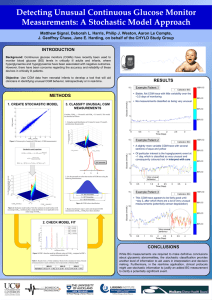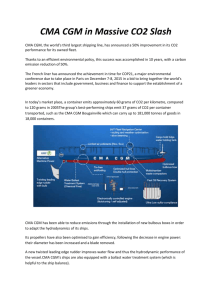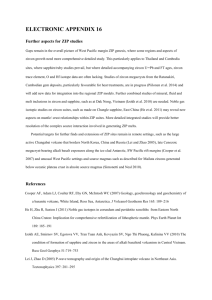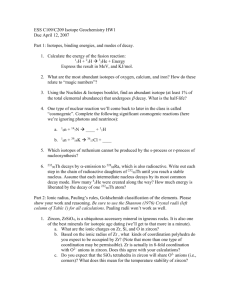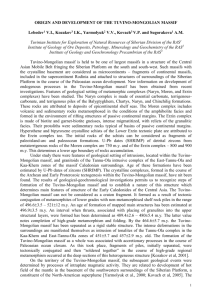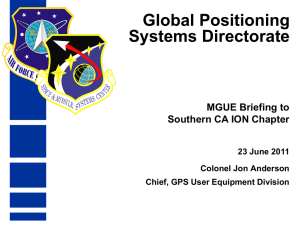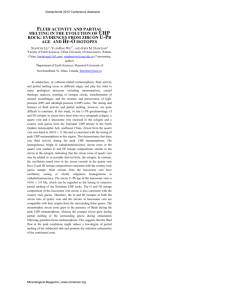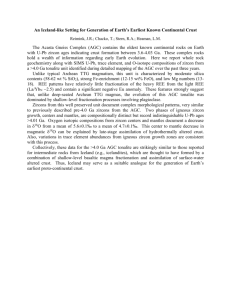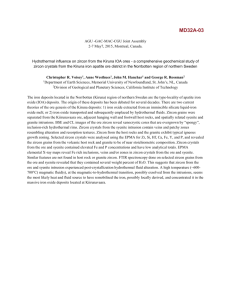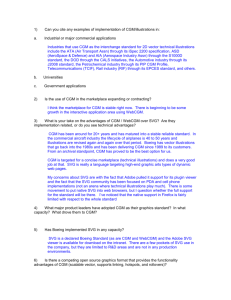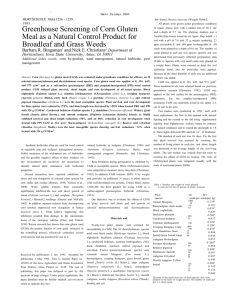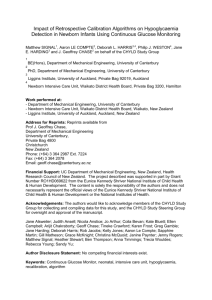Supplementary material to “Chevkinite
advertisement
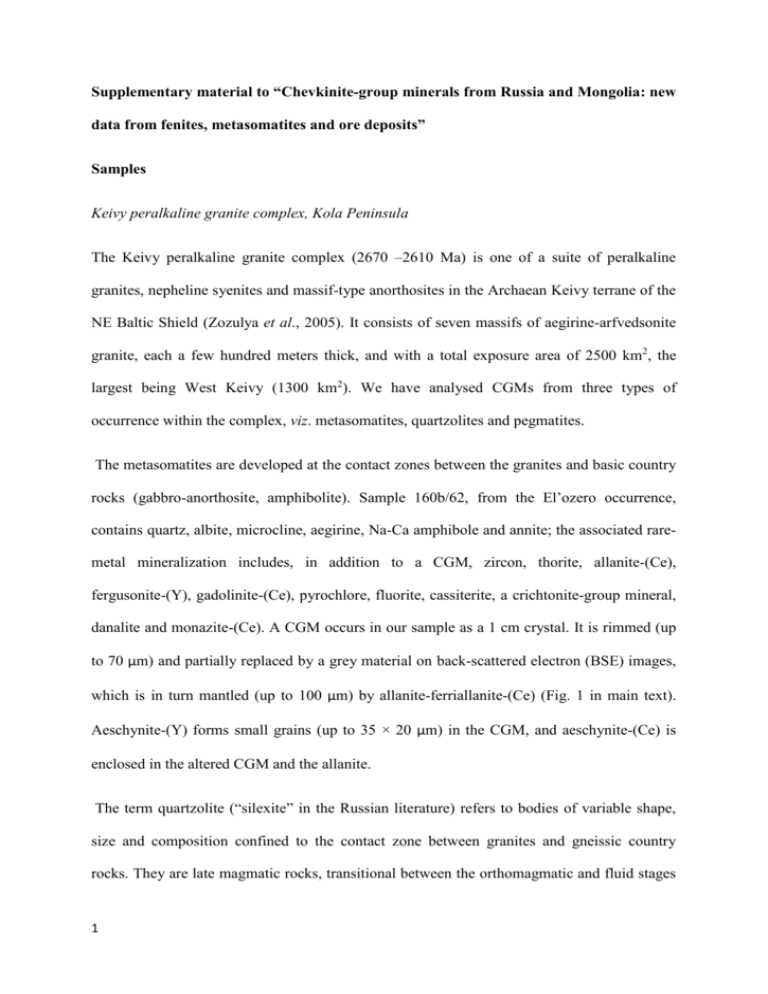
Supplementary material to “Chevkinite-group minerals from Russia and Mongolia: new data from fenites, metasomatites and ore deposits” Samples Keivy peralkaline granite complex, Kola Peninsula The Keivy peralkaline granite complex (2670 –2610 Ma) is one of a suite of peralkaline granites, nepheline syenites and massif-type anorthosites in the Archaean Keivy terrane of the NE Baltic Shield (Zozulya et al., 2005). It consists of seven massifs of aegirine-arfvedsonite granite, each a few hundred meters thick, and with a total exposure area of 2500 km2, the largest being West Keivy (1300 km2). We have analysed CGMs from three types of occurrence within the complex, viz. metasomatites, quartzolites and pegmatites. The metasomatites are developed at the contact zones between the granites and basic country rocks (gabbro-anorthosite, amphibolite). Sample 160b/62, from the El’ozero occurrence, contains quartz, albite, microcline, aegirine, Na-Ca amphibole and annite; the associated raremetal mineralization includes, in addition to a CGM, zircon, thorite, allanite-(Ce), fergusonite-(Y), gadolinite-(Ce), pyrochlore, fluorite, cassiterite, a crichtonite-group mineral, danalite and monazite-(Ce). A CGM occurs in our sample as a 1 cm crystal. It is rimmed (up to 70 μm) and partially replaced by a grey material on back-scattered electron (BSE) images, which is in turn mantled (up to 100 μm) by allanite-ferriallanite-(Ce) (Fig. 1 in main text). Aeschynite-(Y) forms small grains (up to 35 × 20 μm) in the CGM, and aeschynite-(Ce) is enclosed in the altered CGM and the allanite. The term quartzolite (“silexite” in the Russian literature) refers to bodies of variable shape, size and composition confined to the contact zone between granites and gneissic country rocks. They are late magmatic rocks, transitional between the orthomagmatic and fluid stages 1 of evolution, and are dominated by quartz (50 –90 vol.%) with small amounts of feldspars and mafic minerals. Sample Pb176, from a quartzolite within gneisses at the Rova occurrence, West Keivy massif, contains quartz, albite, arfvedsonite, aegirine, annite, magnetite and ilmenite, with, in addition to a CGM, zircon, fergusonite-(Y), britholite-(Y), bastnäsite-(Ce) , thorite and fluorite. Sample 1-93, from the same occurrence, is found in a quartzolite and contains quartz, microcline, aegirine, arfvedsonite, magnetite, ilmenite, fluorite, zircon, samarskite-(Y), britholite-(Y), yttrialite-(Y), thorite and aeschynite-(Ce). The analysed CGM occurs as subhedral plates up to 4 × 2 mm in size. The crystals are patchily mantled by a thin (up to 100 μm) zone of a dark material on BSE images, which also occurs along cracks in the crystal interiors (Fig. 1 in main text). Sample 131/85 is from a quartzolite cutting granite at Pessarjok, West Keivy massif. It contains quartz, microcline, aegirine, arfvedsonite, fluorite, magnetite, ilmenite, and zircon, fergusonite-(Y), britholite-(Y), thorite, yttrialite and a CGM. Sample 5745b is from a quartzmicrocline pegmatite at the contact zone of the Purnach massif; additionally, it contains magnetite, (albite, aegirine), and fergusonite-(Y), britholite-(Y), gadolinite-(Ce), aeschynite(Y) and a CGM. Khibiny massif, Kola Peninsula Our sample (K3) is from DH#597, depth 778.8 m, Umbozero Lake, at the eastern contact of the massif, where it occurs in a metasomatite at the contact between coarsely granular pyroxene nepheline syenites and metasediments of the Imandra-Varzuga series. The metasomatite is a coarse melanocratic rock, composed mainly of ferrikataphorite, nepheline and K-feldspar. It is unusually enriched in titanomagnetite (7.73 wt.% TiO2) and zircon. Minor associated minerals are pyrrhotite and chalcopyrite. The CGM forms euhedral 2 prismatic grains up to 3 mm long, overgrowing zircon and amphibole phenocrysts and contacting nepheline. We analysed 10 points in a 1.5 mm crystal, two points in each of two small crystals (~50 μm), and six points in a 300 μm crystal. Ilmen Mountains, Urals The type locality of the Cr-rich CGM polyakovite-(Ce) is in the Ilmen Mountains, southern Urals, where it occurs in a dolomite veinlet cross-cutting phlogopite-olivine rock (Popov et al., 2001). Our specimen (K2) is a cotype from that locality, Pit No. 97, Ilmen Natural Reserve, Chelyabinsk Oblast. The analysed material is a 0.5 cm long prismatic crystal. Associated minerals are fluororichterite, thorianite and a thorian niobate. Also from the southern Urals, we have analysed a CGM (sample K4) from a syenite pegmatite in vein #35, Vishnevye Mts, Chelyabinsk Oblast. Our sample is a 5mm wide plate, with alteration rims composed of bastnäsite-(Ce) and ilmenite. Burpala alkaline massif, northern Baikal region Portnov (1964) described, from aegirinised syenite pegmatites in the Burpala massif (56°14' N, 110°46' E), perrierite rich in Sr and Zr whose composition can be expressed as (Ce1.17Sr0.88La0.84Ca0.64Na0.27Nd0.15Gd0.09)4.04Fe2+(Ti1.26Zr0.46Mn0.15Al0.10Mg0.03)2.00Ti2(Si3.98Al0. 02)4O22. This phase is of particular interest because it is, in some respects, compositionally transitional between perrierite and rengeite (Sr4ZrTi4(Si2O7)2O8; Table 1). We made 41 point analyses on a roughly rectangular fragment 1110 × 670 µm (sample BP), which shows, on BSE images, stripes of different brightness. Associated minerals are aegirine containing tiny inclusions of pyrochlore-(U), Ca-catapleiite and titanite, plus small pools of zircon thought to 3 have exsolved from the pyroxene. Monazite (Ce-poor) forms strings of minute crystals around the fragment rim. Mushugai Khuduk carbonatite complex, Mongolia Andreev and Ripp (1995) presented an analysis of perrierite from the Apatitovye deposit in the Mushugai Khuduk carbonatite complex, Gobi Desert, Mongolia (44°24'3" N, 104°3'5" E), which contained unusually large amounts of CaO (8.43 wt.%) and BaO (2.06 wt.%). It is difficult to calculate a stoichiometric and charge-balanced formula from their analysis and reanalysis seemed to be in order. Our sample (K1) is from the same locality, collected at a depth of 245 m in drill hole DH#25. We analysed a selection of small crystals, up to 1 mm each, in aggregates. Khaldzan-Buragtag massif, Mongolia The Khaldzan-Buragtag massif (48°24'31" N, 91°57'3" E) has two, northern and southern, parts. The northern outcrop has a linear structure; 90% of its outcrop consists of quartz alkali feldspar syenite. The Tsakhirin-Khuduk ore occurrence occurs on the northern end of the northern outcrop and is associated with bodies of alkali feldspar granite, and peralkaline alkali feldspar and basalt dykes. The ores are related to epidote-quartz metasomatites, with fergusonite-(Y)-zircon-allanite-(Ce) mineralization. Our CGM samples K6, K7 and K8 come from the western ore zone between trenches #3 and #4. Associated minerals are epidote, actinolite, zircon and allanite-ferriallanite-(Ce). The crystals have alteration rims composed of rutile, titanite and hydroxylsynchysite (?). Sample K6 is a rectangular grain, 6 mm across. Sample K7 is a 3 mm bladed grain and K8 is subhedral and 2.5 mm across. Prismatic sample 4 K9 (~7 mm) is from “Point 2300”, in the northernmost part of the western ore zone. The associated minerals are fergusonite-(Y), columbite-(Fe), fersmite, brannerite, zircon, epidote and allanite-ferriallanite-(Ce). Green fibrous alteration rims are formed of rutile, titanite and hydroxylsynchysite-(Ce). Sample K10 was collected in trench #4, western ore zone. The analysed material is a 1 cm subhedral grain, with an alteration rim of titanite, fersmite and allanite-(Ce). References Andreev, G.V. and Ripp, G.S. (1995) About perrierite found in apatite ore. Proceedings of the Russian Mineralogical Society, 124, 83 –84 (in Russian, with English abstract). Popov, V.A., Pautov, L.A., Sokolova, E., Hawthorne, F.C., McCammon, C. and Bazhenova, L.F. (2001) Polyakovite-(Ce), (REE,Ca)4 (Mg,Fe2+) (Cr3+, Fe3+)2 (Ti,Nb)2 Si4 O22, a new metamict mineral species from the Ilmen Mountains, southern Urals, Russia: mineral description and crystal chemistry. The Canadian Mineralogist, 39, 1095 – 1104. Portnov, A.M. (1964) Strontium perrierite in the North Baikal region. Doklady of the Academy of Sciences USSR: Earth Sciences, 156, 118 –120. Zozulya, D.R., Bayanova, T.B. and Eby, G.N. (2005) Geology and age of the Late Archean Keivy alkaline province, northeastern Baltic Shield. Journal of Geology, 113, 601 – 608. 5
